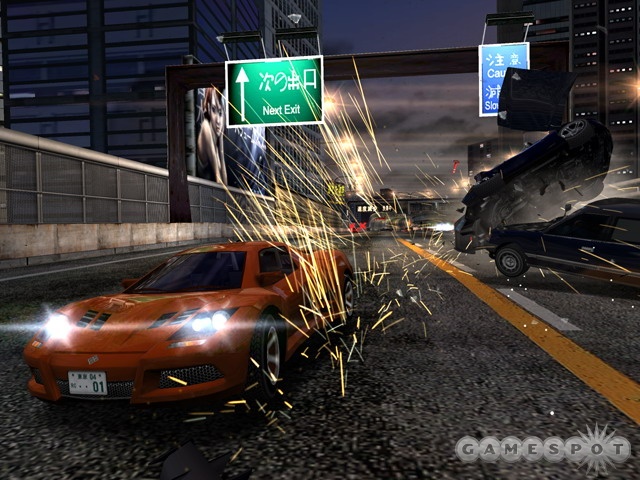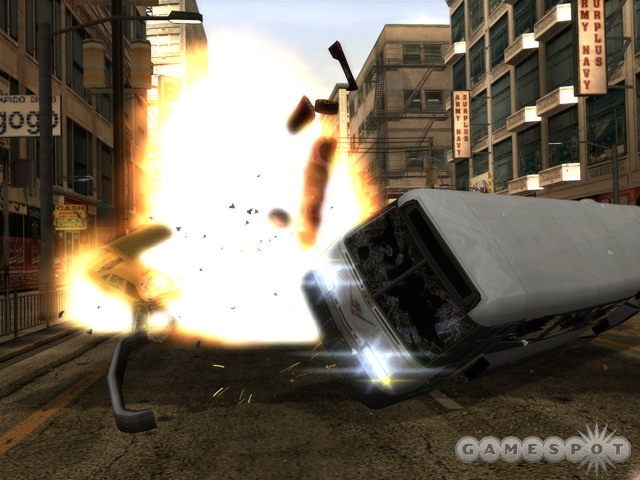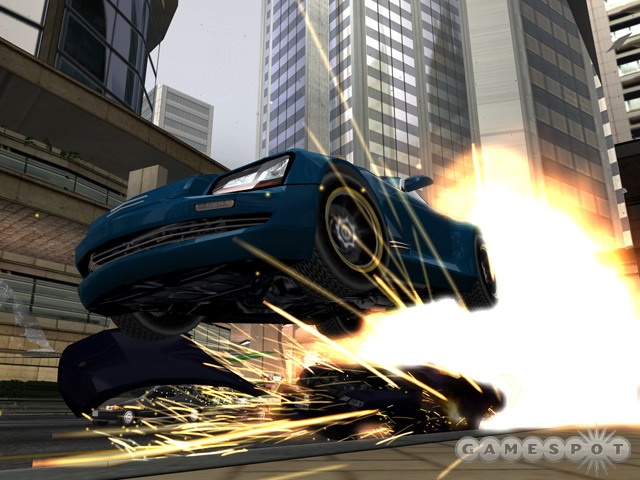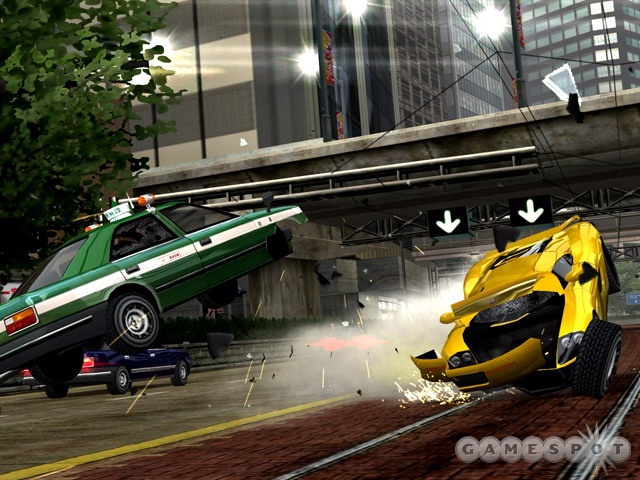Burnout Revenge Q&A
We get some new details on the latest Burnout from executive producer Matt Webster.
According to the Roman satirist Juvenal, who wrote poetry in the early second century, "Revenge is always the weak pleasure of a little and narrow mind." Modern-day English developer Criterion, on the other hand, describes revenge as an exciting new gameplay mechanic that promises to make the next entry in its popular Burnout series a racer like no other. We recently caught up with Criterion's executive producer, Matt Webster, and asked him to explain how the revenge mechanic came about, how it works, and why we're right to be excited about it.
GameSpot: Can you tell us where the idea for the revenge mechanic came from?

Matt Webster: It's the natural progression from Burnout 3: Takedown. Burnout 3 introduced the concept of battling and aggressive racing. One of the highlights was road rage. It had no finish line, no competitors--it was all about taking down as many people as possible before time ran out or your car wrecked. Our fans absolutely loved that mode--as did we--and to this date, it remains the most played mode online. As a result, we decided to make battling the core component of Burnout Revenge. If we're talking about battling, fighting and aggression, well a really key emotion that works through all of this, is the concept of revenge.
GS: Were you worried at all about messing with Burnout's winning formula?
MW: We've never been in the business of change for change's sake. Burnout has always been about accessibility, speed, and crashing. As long as we are able to deliver a game that is accessible to anyone who plays it, faster than any other racing game out there, and has jaw-dropping crashes, then we're delivering on the essence of Burnout. The "revenge" element and aggression focus of Burnout Revenge nails these three tenets and offers the player an experience above and beyond anything we could have imagined back when we were working on ways to take the Burnout franchise.
GS: Why did you think it was time for a change?
MW: We shake things up with each version of Burnout. Burnout 1 was all about racing and crashing. In Burnout 2: Point of Impact, we introduced the element of crash junctions and dialed up on the crashing. Burnout 3 was all about takedowns and hinted at the battling aspect. Burnout Revenge dials up B3's battling component to the nth degree, and delivers a gameplay experience that we feel the fans will absolutely love.
GS: When did you decide to make that the focus of the gameplay?
MW: I think that we saw that the aggression in the game really hooked with people. For the first time, my rivals meant more to me in a race than coming first. This was underlined by how well road rage was received. However, we realized that this aggression wasn't really being called out all through the game. People could win races without fighting and that wasn't the direction we wanted to take it. We wanted to dial everything up a level and make aggression equal progression. It's front and center now. The revenge emotion is pulling the player through the game.
GS: Tell us about the theory behind the mechanics and how it works in practice.

MW: All of the progression is tied to the revenge meter that tracks all of your dirty-handed tactics and progresses you through the game. No longer can you progress by blazing to the finish line before anyone else. If you want to advance in Burnout Revenge, you need to win races by shunting, slamming, and taking down everything in sight! We've also designed all of our game modes around the revenge meter, so whether you're in a race, road rage, or even a crash event, you'll need to make sure that you are earning as many revenge points as possible.
The other brand-new element that we've introduced is the ability to take revenge on the traffic. For the first time, same-way traffic is fair game! You can use it as a weapon to take out your rivals. We reference ice hockey and called this feature "checking traffic." We've also created a brand-new game mode focusing around this!
GS: What did you have to do to your AI in order to have the game offer the experience you were shooting for?

MW: We refined the AI to make it more suitable for the revenge mechanic. A good example of this can be seen in race mode. When you start a race, all of your rivals' place markers are written in blue. This means that they are not out to specifically destroy you, [they're out] just [to] win the race (which may still involve taking you out). The more you target and take down a rival, the more you'll see them target and go after you specifically. When a rival's place marker shifts to red, they are marked for revenge and will specifically be hunting for you. If you manage to take down a rival marked with revenge (red marker), then you will get a revenge takedown, which works into your revenge ratings.
GS: Once those mechanics were in place, how did they affect level design?
MW: We built the tracks for fighting. Instead of seeing nice, long racing corners, expect to see massive jumps, multiple paths, and nasty choke points. The L train portion of the downtown track in B3 is only a small example of what's in store for you in Burnout Revenge. We've also added vertical takedowns, traffic takedowns (launching a traffic car into a rival), and a slew of signature takedowns. The revenge mechanic also plays a major part in our completely redesigned crash mode--but I'll save details on that later!
GS: Can you give us an example of some design elements you tweaked in order to accommodate it?
MW: The entire progression system has been changed and linked to aggression and revenge. As mentioned earlier, the only way to progress through Burnout Revenge is by fighting dirty, taking down your rivals, using the traffic as a weapon, and earning the most amount of revenge points as possible.
GS: How are you modifying the mechanic between the single- and multiplayer modes?
MW: In single-player mode, we're trying to emulate real people and get the intense personal competitive sense that you have when playing with another person. This can best be seen with the way we've tweaked the rival car AI in race mode . They'll come at you aggressively, and that's kicked up a level when you have already taken them out. Really go after an AI rival, and you'll feel it coming straight back at you.
We'll be going into more details about our online gameplay later, but I can tell you that we won't disappoint. B3 has a huge online fan base and we're working extra hard to ensure that they are taken care of and blown away with the online functionality in Burnout Revenge.
GS: Did the revenge mechanic require some rethinking of the visuals in the game (such as visual cues that you wanted to implement to give players a heads-up to incoming trouble, etc.)?
MW: We're calling out rivals that are marked for revenge, we're focusing on really showing off the crashing of the cars, and we do a ton of tricks with traffic, as it's an integral part of Burnout. Additionally, this is an area where audio is really going to work hard for us.
GS: What's your ultimate goal with this new mechanic? Is this a permanent change in the series' direction?
MW: Burnout is about speed, aggression, and crashing, wrapped up in a package that is sharp and accessible. We've always got a ton of ideas!

GS: Now that the game's coming together, how close are you to your original vision for the mechanic, and have you gotten any new ideas on where to take it over the course of development?
MW: Game development at Criterion is about iteration (design, build, play, design, build, play). We are always tweaking and tuning. You can't be precious about changing features to make them better.
GS: Thanks for your time.
Got a news tip or want to contact us directly? Email news@gamespot.com
Join the conversation